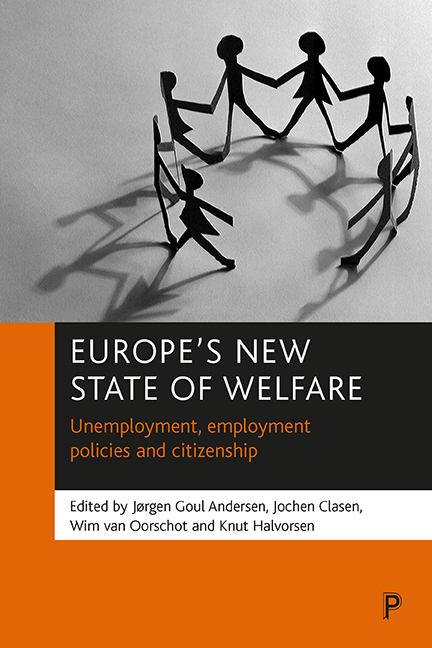Book contents
- Frontmatter
- Contents
- Notes on contributors
- Glossary
- Preface
- one Changing labour markets, unemployment and unemployment policies in a citizenship perspective
- two Employment and unemployment in Europe: overview and new trends
- three Unemployment and unemployment policy in the UK: increasing employability and redefining citizenship
- four To be or not to be employed? Unemployment in a ‘work society’
- five France: the impossible new social compromise?
- six Labour market participation in the Netherlands: trends, policies and outcomes
- seven Is high unemployment due to welfare state protection? Lessons from the Swedish experience
- eight Denmark: from the edge of the abyss to a sustainable welfare state
- nine Unemployment and (un)employment policies in Norway: the case of an affluent but oil-dependent economy: the paradox of plenty?
- ten Unemployment and unemployment policy in Finland
- eleven Slovenia’s navigation through a turbulent transition
- twelve Unemployment and unemployment policy in Switzerland
- thirteen Work, welfare and citizenship: diversity and variation within European (un)employment policy
- References
- Index
- Also available from The Policy Press
six - Labour market participation in the Netherlands: trends, policies and outcomes
Published online by Cambridge University Press: 20 January 2022
- Frontmatter
- Contents
- Notes on contributors
- Glossary
- Preface
- one Changing labour markets, unemployment and unemployment policies in a citizenship perspective
- two Employment and unemployment in Europe: overview and new trends
- three Unemployment and unemployment policy in the UK: increasing employability and redefining citizenship
- four To be or not to be employed? Unemployment in a ‘work society’
- five France: the impossible new social compromise?
- six Labour market participation in the Netherlands: trends, policies and outcomes
- seven Is high unemployment due to welfare state protection? Lessons from the Swedish experience
- eight Denmark: from the edge of the abyss to a sustainable welfare state
- nine Unemployment and (un)employment policies in Norway: the case of an affluent but oil-dependent economy: the paradox of plenty?
- ten Unemployment and unemployment policy in Finland
- eleven Slovenia’s navigation through a turbulent transition
- twelve Unemployment and unemployment policy in Switzerland
- thirteen Work, welfare and citizenship: diversity and variation within European (un)employment policy
- References
- Index
- Also available from The Policy Press
Summary
Introduction
The Netherlands is no exception to the general European trend towards the activation of unemployed people and may even be seen as one of its forerunners. When Wim Kok, the former Labour prime minister, came to power in 1994 and declared ‘work, work, work’ as the central guiding slogan for his government, he only intensified a general policy aimed at increasing the (re)integration of the unemployed that had already been installed in the 1980s by Ruud Lubbers, his Christian-Democratic predecessor. From the early 1980s onwards, the country had been plagued by high numbers of (long-term) unemployed for nearly 15 years. In recent years, however, unemployment has decreased steadily, at present being back at the low levels of the prosperous early 1970s, and employment has skyrocketed. It is generally believed that Dutch activation policies and wage moderation have contributed significantly to this ‘Dutch miracle’ (Visser and Hemerijck, 1997).
In this chapter Dutch activation measures taken in the field of social security and labour market policies are critically reviewed. On the basis of an initial sketch of developments in Dutch (un)employment over the last three decades, the main trends in social security and labour market policy will be discussed, as well as the most important of the actual activation measures taken. Subsequently the nature and extent of the Dutch success story will be subjected to a critical analysis.
Developments in Dutch (un)employment
Following the oil crisis of 1973, unemployment increased from about 50,000 to 200,000 in 1975. This number was unacceptable to the then current government. After the second oil crisis, unemployment figures reached an all time high of 800,000 in 1984. From then on the numbers dropped gradually (among other things because of a change in the government’s definition of unemployment in 1988), but a third economic crisis in the beginning of the 1990s resulted in again rising figures. In recent years, the number of unemployed has decreased significantly. Figure 6.1 shows the sketched development in terms of unemployment rates. In 1999, the rate had returned to its pre-recession level of about 3%, which equals about 250,000 registered unemployed people.
- Type
- Chapter
- Information
- Europe's New State of WelfareUnemployment, Employment Policies and Citizenship, pp. 107 - 122Publisher: Bristol University PressPrint publication year: 2002



